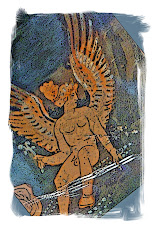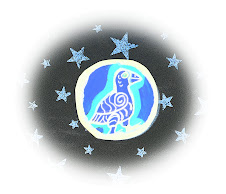
Ghost Theory Expounded Here
Have you experienced a sudden bout of misfortune?
Then your Heinzelmann has probably left you.
(This is the full article that will appear on FairyTaleChannel.org in abridged form, but with all the tedious quotes. This reading is definitely not for the faint of heart.)
What is a ghost? The answer probably depends on whom you’re talking to. The New Oxford American Dictionary defines a ghost as “an apparition of a dead person that is believed to appear or become manifest to the living, typically as a nebulous image.” The dictionary goes on to explain that it is common for ghosts to appear to the living even though they are not really part of this world. Haunting seems to be crucial to their existence for they either spook a person or a locality, but often both at the same time. Ironically much of what we know about the nature of ghosts comes to us from theologians or treatises seeking to dispel widespread belief in them. One of the earliest harangues against ghosts can be found in Deuteronomy 18: 10 – 11, cf. 13: “No one shall be found among you who makes a son or a daughter pass through fire, or who practices divination, or is a soothsayer, or an augur or a sorcerer, or one who casts spells, or who consults ghosts or spirits, or who seeks oracles from the dead.” Despite these assaults on popular tradition, belief in ghosts has flourished and these spirits often appear in fairy tales wandering the earth or even possessing a living person (on this website see Gratzug, Crossing to Remagen, True Eckart and Frau Holle, Ghost as Married Woman, Ghost of Boyne Castle).
Unwittingly, perhaps, the Catholic Church promoted belief in ghosts in their doctrine of purgatory, which provides a middle place for souls transitioning between life and death and thus a physical place for ghosts to reside. It was Augustine who finally endeavored to bring the teachings of the church into sharper focus and overturn popular superstition. He did not deny the existence of ghosts but did argue instead that their appearance and activity were due to demonic forces acting in the world. This rationale was continued in the 18th century when the German theologian Johan Ernst Schubert outlined his Ghost Theory in two treatises: The Appearance of Souls after Death and The Location of Souls after Death. Here Schubert explores the various notions of what happens to us at death and the nature of ghosts in general. Yale University has several items in its rare books collection written by Johann Ernst Schubert, but I am not aware of any library in America that holds this particular work. I am therefore posting excerpts of translations of Schubert’s text because they illuminate folk beliefs reflected in many of the fairy tales posted here.
What is the essence of a ghost? To Schubert this question is inextricably tied to the nature of our souls. He says “The soul is in and of itself an invisible essence. If we assume that the soul is located near the ashes (or decay) of its body, you still would not be able to see it or sense it. If it appeared, the soul would either have to re-construct the body, in which it formerly dwelled or build a body from other material to be able to appear to the eyes of the living. The one thing is just as impossible as the other….. "
Thus souls are not body-builders, but instead more like invisible clouds or transparent vapor. Schubert envisions them hovering close to their limp and decaying bodies, or, by extension inhabiting the cemetery.
Why are we so preoccupied with the notion of ghosts? This is also clear to Schubert:
“… From the minute we hear that a friend has died, whom we knew intimately, we cannot think about him without secretly feeling pangs of terror. Judge for yourself, gentlemen, whether or not this is based on the belief that the souls of the dead can appear to the living! (see The Shroud, Bread Shoes). Because who would be so silly as to fear lifeless bodies, which no longer have the strength to move? The whole world must admit that no one is safer than in the company of the dead. The living can harm us if they choose. But the dead don’t even have the strength to insult us. One would have to imagine that the souls of the dead congregate by the graves of their decaying bodies (which they used in this life) and that they are now wandering ghosts, which only appear to terrify the living….”
(He contradicts himself a bit, arguing in the first paragraph that souls are invisible and hover near their bodies only to ridicule the idea here.)
Can dead souls appear as ghosts? The answer is a bit convoluted, but worth slogging through:
“If (dead souls) could move their former bodies and use these bodies as they wished, then men could readily rise from the dead if they wanted to. But this motion of the dead body would constitute a reunification with the soul and a (ghostly) manifestation of this type would signify a return to the present life. This cannot be the case because precisely at the time one imagines an appearance of a ghost, the dead body is resting in its grave and a large part of the body has already turned to dust and decay. And even more impossible is for souls to return to their prior bodies, which they relinquished many hundreds of years before. The (souls) would have to collect their (body) parts from all regions of the world if they wanted to reinvigorate and reawake their bodies.”
What happens to the soul at death? Schubert admits there is no unanimity among scholars on this point but nevertheless takes a stab and perhaps inadvertently leaves the door open regarding all manner of ghosts:
“At the moment my soul leaves the protection of this body, it either receives another body to accompany it into eternity or it remains cut off from all other earthy matters until the time arrives when the dead come forth from their graves. If according to God’s wisdom it has acquired (zuzueignen) a new body, which would be fashioned according to its future needs (Beschaffenheit), it would perhaps be possible for it to establish, with God’s help, a visible body and show itself in this form to the living. But this is a belief I cannot support. I admit that among wise scholars there are those who believe that departed souls can move into new and subtle bodies and remain there until they can return to their own abandoned body. But (disembodied) departed souls have no need of such an abode. They can still remember their past deeds without such a dwelling; they can still recognize whether they are in the company of God’s chosen or among the damned; they can still behold God’s visage but also feel his wrath and sense the unbearable terror of a gnawing conscience. Union with a body would only mean that feelings of joy or damnation would be multiplied by external (bodily) sensations. This will only happen when the Almighty Judge awakes the flesh of the dead and holds His terrible Last Judgment. I admit that at the start of their existence incarnating ghosts require bodies. But for those who have already lived in a body and have collected a multitude of varied experiences, one must draw another conclusion. And this is the case for where the departed souls of men reside.”
Do ghosts ever appear to men?
“I don’t want to deny that up to now such figures have been seen among men, often being likened to the dead and some have claimed they are souls. I think this is possible although many appearances of this kind have either been a fraud or the mistaken fantasy of fearful men. You don’t have to believe that the souls of the dead are those reappearing in this life for we are not the sole spirits to be found on this earthly sphere. There are a great number of other creatures of this kind. They do not always live among us, but also seldom care to leave us. These spirits are very strong and powerful. Their purpose devised by a wise and almighty creator stipulates that they become unified with subtle, fast and invisible bodies. They do amazing things with the help of the same forces. Among their machinations I find this the least noteworthy, to make a visible body from the matter that they encounter everywhere, which is similar to a human form, to become one with this form and then to appear to humans. It follows that it is also possible to pretend to be a person who died several years ago and if it will benefit their purposes, to assure the living that they are the departed soul of this or that person, the name of which they must still know. This is a fraud which one would not experience from a saint or honorable spirit. When people have been terrified by such apparitions, this is the work of such a ghost, called by various names, Prince of Darkness or Master of the same realm.”
In other words, the re-appearance of a dead person to the living is possible but only through a demonic force or devil. But according to Schubert, there are three ways to combat encounters with such spirits:
“The evil spirit only appears in the form of a deceased person, where ignorance and superstition rule. This spirit does not come easily to those who walk in the light of truth. (for an example of such a person, see the Fairy Tale Frau Trude) .
There is not the slightest reason to fear such apparitions or to avoid places where one keeps the bones of our departed brothers. For it is not their souls, that are seen in this form. In view of the first comment, one must also point out that the devil never wakes the shadow of a dead person for the purpose of harming our body or attacking us. (The Skull taken from the Bone House, 125)
Thirdly, one must take great care not to become part of the number of godless and damned, in whose created form he has appeared. Because he has known his friends and foes in this life, it is possible to present himself as a god-fearing or godless person. It often is more advantageous to show himself in the form of a just and pious dead person than to wander around as the shadow of a villain. For this is a trick.” (Frau Trude)
So much for Schubert and his ghost theory. Vernacular literature offers a rich variety of ghosts that do not fit so neatly into his organized theology. The ghosts of fairy tales and legends haunt mountains, forests, lakes and even houses. They are not the dead stuff of Schubert's theology! In popular lore ghosts prefer the winter season and the time around All Soul’s Day (November 1) was believed to be the time it was easiest to breach the barrier between the living and dead. In cold and dark months they can often be seen running merrily through a courtyard, riding in a sled, playing music or dancing in the parlor. They love to wear colorful garb adorned with bells and seek human companionship. The Swedish Tomte is one such ghost. He has the stature of a child but the face of an aged man. Often appearing in a red cap, an offering of tobacco or a shovel-full of earth would appease such a house spirit. These ghosts, known as kobold, shellycoat, brownie or heinzelman love to play tricks on the mortals with whom they live. They love to laugh and perform mundane household chores for the family they haunt. But their persistent appearances are often perceived as an annoyance, their rituals a nuisance or even an embarrassment to the master of the house. Instead of receiving a small boon, house spirits are often rebuked with unkind words or jokes. This enrages the kobold and causes him to leave the family he has been associated with for centuries. When the ghost leaves, the family’s fortune collapses. In German folk traditions these spirits are often named Huetchen, Hopfenhuetel, Eisenhuetel, Heinz, Butz or Butzenhaensel. These ghosts like to live in the stable, cellar, silo or even a favorite tree. Often they have their own room in the house under the eaves and a soft indentation can be seen on the pillow or chair where they sleep. Or they may even sleep in the same bed as the humans, with whom they live. On Thursday these spirits will not tolerate any wood-cutting or spinning. They love to play the harp, talk to everyone in the household and reveal secrets. Because of this familiar relationship, they are often referred to as uncle or father-in-law. But there is also a more sinister form of these spirits, who are then referred to as poltergeist or rumpelgeist.
Here are the various names of house ghosts or spirits in saga and fairy tales:
Aitvaras (Lithuanian house ghost, his manifestations include black rooster, black cat or flying snake. A devil or evil spirit, who demands the soul of the person he haunts and then richly rewards him (Faust))
Bukura e dheut (Albanian fairy. Helpful and very powerful. Only a god or angel is capable of performing the same functions. Her castle is guarded by magical animals. Sometimes she has a demonic connection. She is protected by a three-headed dog.)
Brownie (Scotland and Northern England: a house ghost. Similar to a Heinzelmannchen in Central Europe. In Cornwall, Brownies are responsible for guarding bees.)
Domovoj (Russian, ghosts incarnating from dead souls, they protect the family and its cattle).
Druden (Truden, Old Norse trotha meaning “treten or “stossen”) (A female demon appearing especially in Southern Germany and Austria who disturbs sleep or performs evil magic. The word “Trute” is middle-high German for “ghost” and is synomynos with “witch”. The pentagram or “Drudenfuss” was a protection against evil spirits (Goethe’s Faust).
Elves (Old English Aelfen. There were 3 types: Mountain Elves, Water Elves or Forest Elves. The English tradition characterizes them as lovely female spirits and they appear in German literature in this form in the 17th century. They love music and dance. Herder and Goethe refer to their king as “Erlkoenig”
Haltia (Finnish “protector”, ghostly protectors of a house, mill or hearth/fire. The person who first establishes or builds a house or who first made fire in the house can become this house spirit.
Heinzelmaennchen (Germany, Central Europe, helpful house spirits of gnome-like stature with red or green clothing and usually with red hair. They are indefatigable helpers of house occupants and provide good advice. Mean spirited comments or curiosity drive them away. Also called Heinzlein (short form for Heinrich) and a euphemism for a demon or devilish spirit.
Juma (Finno-Ugric, Finnish for ghosts of the earth, water, wind and house.)
Kobold (Central European, beneficient house spirit. Name means chamber, house (English: cove) and old (walten/ruling), the spirit ruling the house. Also appear as mountain spirits, who rob silver and return valueless cobalt. They work as invisible spirits toward the good of the house.)
Majas gars (Latvian house ghost. Even in the 19th century Latvian farmers hoped to achieve the beneficence of such spirits through prayer and offering, thus assuring the fortune of the house and its inhabitants.
Para (Finnish folk tradition, a house ghost that often appears in the shape of snake, frog or cat; responsible for multiplying a household’s fortunes in the form of grain, milk, butter and also money.
Pukis (Lithuanian dragon helping function as house guide and treasure-bringing dragon.
Shellycoat (Scottish kobold, loves bells on clothing, likes to play tricks and laugh, acts as true servant but presence perceived as annoyance)
Teraphim (Hebrew for house idol, bestowing charity and riches to a family, assumes a position of honor and leadership within the family, assures family’s inheritance and also serves oracular purposes. Book of Judges.
.jpg)
.jpg)
